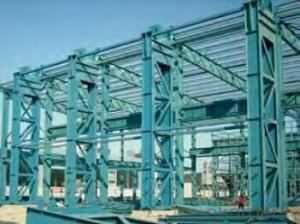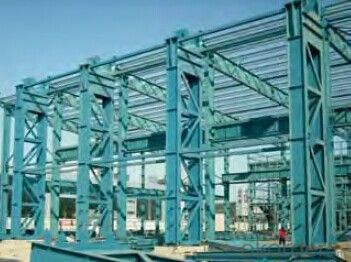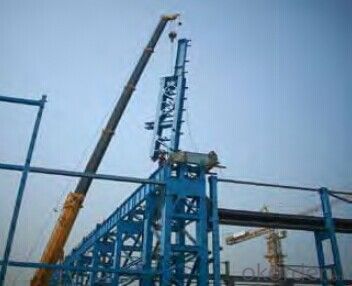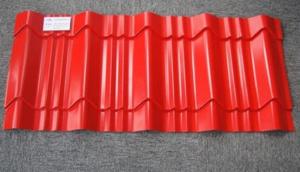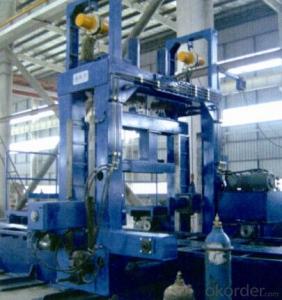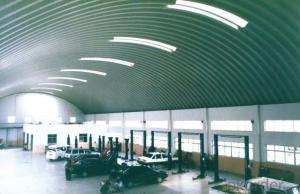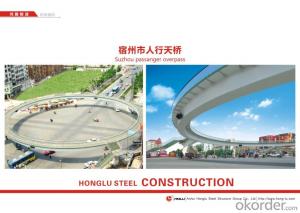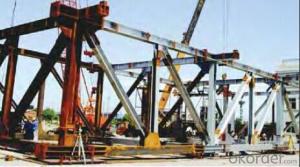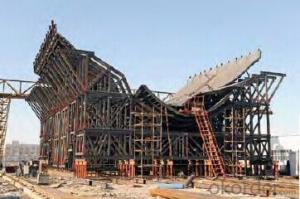Steel Construction made in China
- Loading Port:
- China Main Port
- Payment Terms:
- TT OR LC
- Min Order Qty:
- -
- Supply Capability:
- -
OKorder Service Pledge
OKorder Financial Service
You Might Also Like
Steel Structure
Description:
1.Length of the welding withnot indication, full welding should be applied
2.Seam without indication is fillet weld, height is 0.75t
3.The cutting angle without indication, radius R=30
4.Cutting angle not specified should be
5.The diameter of the hole for the bolt if not specified, D=22

Project Reference:
For the Steel structure project of Upper part of external
piperack for air separation and gasifying facilities of
460,000 tons MTO (Methanol to Olefins) project in
Duolun, we provide about 4,500 tons steel structure. It
is a heavy chemical indusry of national energy project.
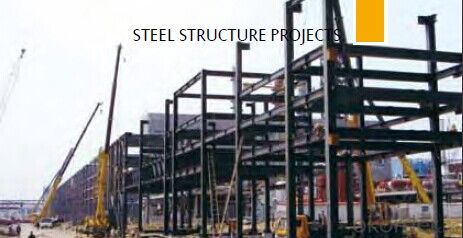
- Q: How are steel structures designed to be aesthetically pleasing?
- Steel structures are designed to be aesthetically pleasing through various design elements and techniques. One of the key factors is the use of clean lines and sleek profiles, which contribute to a modern and minimalist aesthetic. Steel allows for flexibility in design, allowing architects and engineers to create unique and visually striking structures. Another way steel structures are designed to be aesthetically pleasing is through the use of innovative and creative shapes. Steel's strength and versatility allow for the creation of complex and intricate structures that can capture attention and create a sense of awe. This can be seen in iconic steel structures such as the Eiffel Tower or the Sydney Opera House. Additionally, the use of steel allows for large open spaces and expansive glass facades. This creates a sense of transparency and lightness, making the structure appear more inviting and visually appealing. The combination of steel and glass also allows for natural light to enter the building, creating a pleasant and dynamic atmosphere. Color is another important aspect of steel structure design. Steel can be painted in a wide range of colors, allowing architects to incorporate vibrant and eye-catching elements into the design. The choice of color can be used to complement the surrounding environment or make a bold statement, depending on the desired aesthetic outcome. Lastly, the integration of steel structures with the surrounding landscape or urban environment is crucial for creating an aesthetically pleasing design. Steel structures can be designed to blend in with the natural surroundings or complement the architectural style of the area. Proper landscaping and lighting can also enhance the visual appeal of steel structures. In summary, steel structures are designed to be aesthetically pleasing through the use of clean lines, innovative shapes, large open spaces, vibrant colors, and integration with the surrounding environment. These design elements work together to create visually striking and captivating structures that can enhance the overall aesthetic appeal of any space.
- Q: How are steel structures tested for strength and durability?
- Steel structures are tested for strength and durability through a series of standardized procedures. This includes conducting destructive and non-destructive tests such as tensile and compressive tests, bend tests, impact tests, and fatigue tests. Additionally, steel structures are evaluated through visual inspections, ultrasonic testing, magnetic particle inspection, and X-ray testing. These tests ensure that steel structures meet the required safety standards and can withstand various loads and environmental conditions over their intended lifespan.
- Q: How do steel structures perform in fire conditions?
- Compared to materials like wood or concrete, steel structures generally exhibit good performance in fire situations. This is primarily attributed to the high melting point and heat resistance of steel. When subjected to fire, steel structures initially experience a decrease in strength as the temperature rises. However, they still maintain a significant amount of load-carrying capacity even at high temperatures. Unlike wood, steel does not burn or contribute to the fire, which helps prevent the rapid spread of flames. Another unique characteristic of steel structures is their ability to expand when exposed to heat. This expansion aids in dissipating the heat and preserving the structural integrity of the steel. The flexibility of steel connections and the overall design of the structure can accommodate this expansion. Additionally, fire-resistant coatings or insulating materials are often applied to steel structures to further enhance their fire performance. These coatings slow down the transfer of heat to the steel members, allowing for more time for evacuation and firefighting efforts. It is important to note that the fire resistance of steel structures depends on several factors, including the fire load, duration of exposure, and design considerations. Therefore, fire safety regulations and building codes are crucial in ensuring that appropriate fire protection measures are implemented for steel structures. Overall, steel structures have proven to be reliable and resilient in fire situations. By incorporating proper fire protection measures, such as coatings and insulation, steel buildings can withstand fires and provide a safer environment for occupants.
- Q: How are steel structures designed to provide adequate ventilation and air circulation?
- Steel structures are designed to provide adequate ventilation and air circulation through the incorporation of strategically placed openings such as windows, doors, and vents. Additionally, HVAC systems can be installed to further enhance air circulation within the building. The design also considers the flow of air currents and incorporates features like louvers or exhaust fans to ensure proper ventilation throughout the structure.
- Q: What are the different types of steel sections or profiles used in construction?
- Some common types of steel sections or profiles used in construction include I-beams, H-beams, C-channels, angles, and tubes. These sections are designed to provide structural support and are often used in the construction of buildings, bridges, and other infrastructure projects.
- Q: Can steel structures be designed to withstand extreme temperature variations?
- Absolutely, steel structures have the capability to endure extreme temperature variations. Steel, being an incredibly adaptable and resilient material, has the capacity to withstand a wide array of temperatures. However, it is important to note that extreme temperature variations can present challenges for steel structures, which necessitate meticulous design considerations. To guarantee the endurance of steel structures in conditions of extreme temperatures, engineers employ various strategies. Firstly, the selection of suitable steel grades is of utmost importance. Certain alloys, like stainless steel or high-temperature resistant steel, are specifically engineered to withstand extreme temperatures while maintaining their structural integrity. Secondly, the design of the structure must take into account thermal expansion and contraction. Steel expands when subjected to heat and contracts when cooled. Engineers incorporate expansion joints and flexible connections to accommodate these changes, thus preventing potential damage caused by thermal stress. Insulation is another critical aspect in the design of steel structures for extreme temperature variations. By incorporating insulation materials such as mineral wool or foam panels, the steel structure can resist heat transfer and minimize the impact of temperature fluctuations. Insulation also aids in regulating the internal temperature, resulting in a more energy-efficient structure. Furthermore, fire protection measures are imperative for steel structures in conditions of extreme temperatures. The inclusion of fire-resistant coatings, fireproof insulation, or fire-resistant materials can enhance the structure's ability to withstand high temperatures and prevent structural failure during a fire. To conclude, it is indeed possible to design steel structures that can endure extreme temperature variations. Through careful selection of materials, appropriate design considerations for thermal expansion, insulation, and fire protection, engineers can ensure the structural integrity and longevity of steel structures even in harsh temperature environments.
- Q: What is the importance of steel quality in structural design?
- The importance of steel quality in structural design cannot be overstated. Steel is widely used in construction due to its exceptional strength, durability, and versatility. However, the quality of the steel used is crucial in ensuring the structural integrity and safety of buildings and other structures. One of the primary reasons why steel quality is essential in structural design is its ability to withstand various loads and forces. Different types of structures experience different types of loads, such as dead loads, live loads, wind loads, seismic loads, and temperature variations. High-quality steel with specific properties, such as high yield strength and ductility, can resist these loads effectively without deformation or failure, ensuring the stability and longevity of the structure. Another critical aspect of steel quality is its resistance to corrosion. Steel structures are often exposed to harsh environmental conditions, such as moisture, chemicals, and extreme temperatures, which can lead to corrosion. Corrosion weakens the steel, compromising its structural integrity and potentially leading to catastrophic failures. By using high-quality steel with proper corrosion-resistant coatings or alloys, the risk of corrosion-related issues can be significantly reduced. The consistency and reliability of the steel's mechanical properties are also essential for structural design. High-quality steel manufactured with strict quality control measures ensures predictable and consistent mechanical properties, such as yield strength, tensile strength, and elongation. These properties are crucial in determining the structural design parameters, including the size and configuration of members, connections, and overall stability. Inaccurate or inconsistent properties can lead to overdesign, underdesign, or even structural failure. Furthermore, steel quality plays a significant role in achieving cost-effectiveness in structural design. By using high-quality steel, designers can optimize the structural system, reducing the material quantities and associated costs. Additionally, the use of high-quality steel allows for more efficient fabrication and construction processes, resulting in time and cost savings. Lastly, the importance of steel quality is reinforced by the need for compliance with industry standards and codes. Structural design codes, such as the American Institute of Steel Construction (AISC) standards, specify minimum requirements for steel quality to ensure the safety of structures. Adhering to these standards ensures that the steel used in structural design meets the necessary criteria for strength, durability, and performance. In conclusion, steel quality is of utmost importance in structural design due to its significant impact on the strength, durability, and safety of structures. By using high-quality steel, designers can create structurally sound and cost-effective solutions that meet industry standards and ensure the long-term stability of buildings and other structures.
- Q: What are the common design considerations for steel healthcare facilities?
- Some common design considerations for steel healthcare facilities include structural integrity and strength, fire resistance and prevention, infection control and prevention, flexibility and adaptability for future expansions or renovations, and sustainability and energy efficiency. Additionally, considerations for patient comfort, staff efficiency, and compliance with healthcare regulations and standards are also important in the design process.
- Q: How are steel structures maintained and repaired?
- Steel structures are maintained and repaired through a combination of regular inspections, preventive maintenance measures, and timely repairs. Regular inspections are crucial to identify any signs of damage, corrosion, or structural weakness. These inspections are typically conducted by trained professionals who examine the structural components, connections, and overall condition of the steel structure. Preventive maintenance is an essential aspect of steel structure maintenance. It involves implementing measures to minimize the potential for deterioration and damage. This may include applying protective coatings or paints to prevent corrosion, ensuring proper drainage to prevent water accumulation, and maintaining a clean environment to avoid the buildup of debris or pollutants that could harm the structure. In case damage or deterioration is identified during inspections, repairs need to be promptly carried out to prevent further deterioration and maintain the structural integrity. Depending on the nature and extent of the damage, repairs can range from minor repairs, such as fixing small cracks or replacing corroded fasteners, to major repairs, such as replacing damaged sections or reinforcing weakened areas. Repairs can be conducted by welding, bolting, or riveting, depending on the structure and the type of damage. Welding is often used for joining new steel plates or reinforcing damaged sections. Bolting and riveting are commonly employed for connecting structural elements and replacing damaged fasteners. These repair methods require skilled professionals who are trained in the specific techniques and safety precautions associated with steel structures. It is worth noting that the maintenance and repair of steel structures should comply with relevant industry standards and guidelines. These standards provide a framework for ensuring the safety, durability, and reliability of steel structures. Regular training and certification of maintenance and repair personnel are also essential to ensure their competency and adherence to these standards. By implementing regular inspections, preventive maintenance measures, and timely repairs, steel structures can be effectively maintained and their service life prolonged. This proactive approach helps to minimize the risk of structural failure, enhances the overall safety of the structure, and ensures its long-term performance.
- Q: How are steel structures designed to support heavy loads?
- Steel structures are specifically designed to support heavy loads by utilizing the inherent strength and properties of steel. The design process for steel structures involves several key considerations and techniques to ensure their ability to withstand and distribute heavy loads effectively. Firstly, the design of steel structures takes into account the anticipated loads that the structure will be subjected to. This includes considering the weight of the structure itself, as well as any additional loads such as equipment, furnishings, or environmental factors like wind or seismic forces. These loads are carefully calculated and analyzed to determine the required strength and capacity of the steel members. Next, steel structures are designed with a focus on the principles of load distribution. This involves distributing the loads evenly across the structure to minimize stress concentrations and prevent localized failures. Techniques such as truss systems, beams, and columns are employed to transfer loads from the point of application to the foundation, ensuring that no single member is subjected to excessive stress. Furthermore, steel structures often incorporate redundancy in their design. This means that multiple members or systems are utilized to carry loads, providing an additional level of safety and allowing for the redistribution of loads in case of failure. This redundancy ensures that heavy loads can be supported even under unforeseen circumstances. In addition, steel structures benefit from the material properties of steel itself. Steel is known for its high strength-to-weight ratio, which means that it can support heavy loads without requiring excessively large or heavy members. This allows for more efficient designs and reduces the overall weight of the structure. Finally, steel structures are constructed using precise fabrication and erection techniques. The use of advanced welding, bolting, and connection methods ensures the integrity and strength of the structure. These techniques, coupled with regular inspections and maintenance, help to ensure the long-term ability of steel structures to support heavy loads. Overall, the design of steel structures to support heavy loads involves a combination of careful load analysis, efficient load distribution, redundancy, utilization of steel's material properties, and proper construction techniques. By considering these factors, steel structures are able to provide the necessary strength and stability to support heavy loads safely and effectively.
Send your message to us
Steel Construction made in China
- Loading Port:
- China Main Port
- Payment Terms:
- TT OR LC
- Min Order Qty:
- -
- Supply Capability:
- -
OKorder Service Pledge
OKorder Financial Service
Similar products
Hot products
Hot Searches
